There was a lot of learning and much motivation given on this year’s Pasture for Life study tour
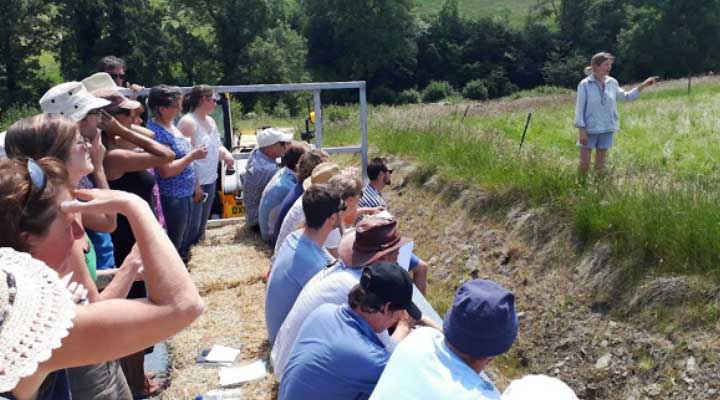
Day 1: Smiling Tree Farm
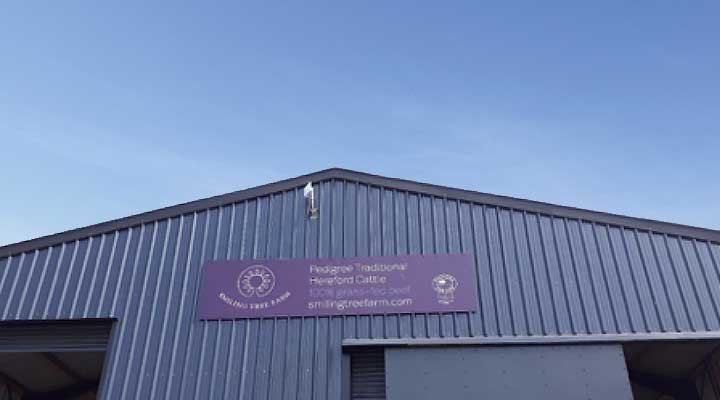
The tour kicked off with lunch on day 1, kindly prepared by our host Christine Page – including some of her delicious home-made Pasture for Life burgers – before settling down in Christine’s beautifully converted oak-floored barn to commence the learning! The delegates started the tour with a round of introductions, including a few comments on what they hoped to get out of and learn more about during the 2 days:
- Direct sales & profitability
- Agroforestry
- Tap into knowledge
- Marketing and promotion
- Grazing management
- Different routes to market
- Current thinking
- Mob grazing
- Handling Units
- Absorb knowledge
- Find land
- Get ideas
- Improve nature value
We heard from Christine, who gave a talk on the ethos behind Smiling Tree Farm and its holistic principles. The farm is home to a small suckler herd of Traditional Hereford cattle that produce slow-matured beef, Shetland sheep provide lamb & hogget, and a micro-dairy with Jersey cows milked once-a-day produce raw milk, cream, butter and rose beef from a calf-at-foot system. The beef, lamb & dairy are all certified Pasture for Life.
Christine emphasised her objective to present “best practice of small-scale farming” and to leave the land in a better state than that which it had been found. That, she said, gave her mob grazing system an aim: to produce nutrient rich and tasty meat from healthy livestock in a healthy environment.
Farm finances
The farm has to pay for itself. £1400-£1500 per beef animal is made from selling direct (before overheads). Direct selling milk is even more profitable especially with a low cost grass-fed system, despite the low production. Christine is selling her raw milk at £2 litre. The farm makes £40,000 before overheads.
Smiling Tree Farm tour
We headed out into the glaring heat for a trailer tour across the magnificent Shropshire Hills that Smiling Tree farm is situated in.
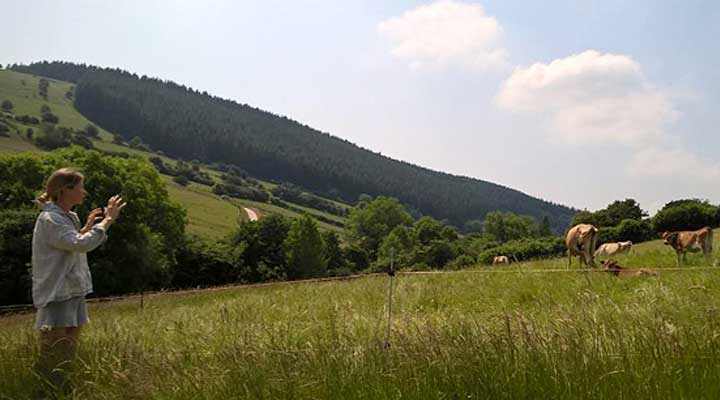
Dairy
First up was the dairy herd. The dairy cows are mob grazed and spend 3 days in each section, the main restraints being access to shelter/hedges (particularly in hot weather) and water. They are put on to long grass (plate metre reading of 1600 DM/hectare) and therefore have a high carbohydrate diet. The cows tend to hold their weight better on their second lactation with this diet.
Christine gets 6-8 litres a day (milked once in the morning) from her milking cows and the rest is left for the calves. The calves are separated from their mums overnight so that they can’t suckle, allowing for cows to be milked in the morning. Calves start to be separated from their mums in the first week of life so that they get used to it and becomes very normal. They may be put with an older, non-lactating cow for company. The system works well and doesn’t impede their development.
Suckler herd and handling system
We continued down the valley and up the other side to where the beef suckler herd is kept. (The beef and dairy herds are kept separate to avoid any cross-contamination, especially important for the sales of raw milk.)
Inside Christine’s new cattle barn, we found the Pierson Squeeze Crush designed by Temple Grandin. Cattle are gently squeezed as they enter the crush, which actually relaxes and reassures the animals. There is a curved race feeding the crush and the pen is all boarded up so that the cattle cannot see what is going on in the crush and vice versa – this prevents them from getting spooked. Christine uses the ‘baling twine’ trick to move the cows through the crush – as they are trained to an electric fence, they treat it in the same way. (This was a tip picked up from the PFLA’s Google group forum, one of many that Christine has read about and used).
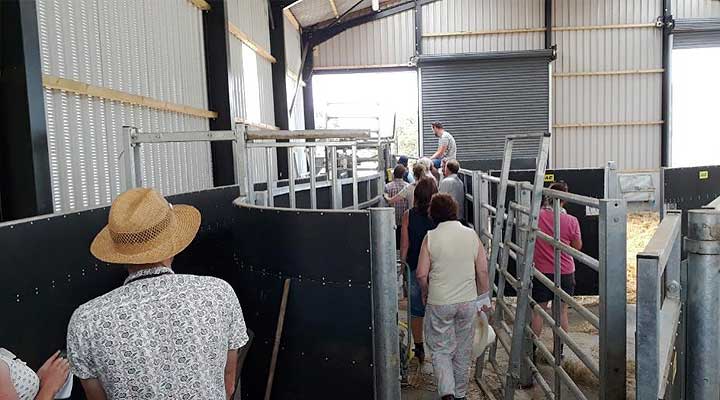
Cows are brought in to the barn in winter as the land is just too sloping and the soil too heavy for them to stay out all year. Christine has set up the farm so that it is easy to manage by herself – she has spent money to get the right infrastructure in place. Currently, the farm work takes up half a day per day of her time.
Rainwater harvesting tanks – 2 x 12,500 litres, collecting all water from the shed roof (there’s a calculation you can do to make sure you choose the right size of tank for your roof size to ensure water doesn’t go stagnant). “Gutter hedgehogs” are used to stop leaves/other debris getting into the tank. The tanks had been installed since Christmas, and so far the mains supply had not been required for the beef herd. The gravity fed water system makes use of the steep land and Christine invested in concrete troughs – although more expensive up front, they don’t rust and last a lifetime making them more efficient long term.
Nature and Holistic Approach
There are 20 species of hedging plants in the newly planted hedgerows – Christine wants it to look amazing, whilst also being good for nature, increasing the diversity and better for the animals on the farm. In this way, the farm becomes holistic, as the increased species is good for Christine, good for her customers, as well as her neighbours, animals and the wildlife.
The healthier the cow the less fly stricken they prove to be. Christine uses no vaccinations or wormers in order to naturally promote healthier guts and healthier animals. In fact, Christine uses no routine treatments at all, preferring a whole species approach using as little inputs as possible and which gives the animal an innate robustness.
Herefords
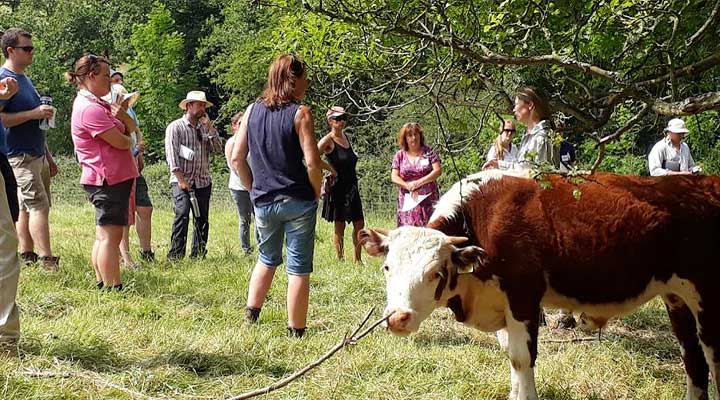
The herd’s breed is Original Population Herefords, with no crosses at all. Christine keeps 10 cows plus their followers – no heifers are kept in the herd, they all go for beef. All bull calves are rung and steered straight away. A small amount of “herbal hay” is made each year, which is given to the cattle every few weeks throughout winter as a medicinal treat.
Christine is not trying to meet a supermarket specification – instead just good tasting, nutritious meat from animals that look like “a barrel on 4 pins”. She uses a small, family run abattoir in nearby Leintwardine. She even takes the time to see the whole process through in the abattoir by donning her whites and watches the carcass to ensure she gets back the right animal’s offal.
Marketing workshop
Unique Selling Points
Back in the barn the delegates were asked what the unique selling points of their way of farming and production were. The following points were voiced:
- Wildlife Friendly – grazed for benefit of wildlife
- Taste
- Yellow fat
- Dark red meat
- Local (more than organic) and supporting local businesses, part of the chain
- Natural – how it’s produced
- Transparency – seeing it done
- Personal contact with farmer – know your farmer
- Low inputs, carefully managed (hard to explain)
- High Animal welfare – care has been taken to produce the product
- Human – Animal – Planet friendly
- Health benefits – nutrition
- Traceability
- Breed – natives
- Outdoor reared
In addition, producers selling livestock as stores felt that the Pasture for Life system also brought USPs for them too:
- The natural diet during the development of the animal’s gut would help to ensure it would finish just on pasture later in life.
- Growth potential – likely to exhibit compensatory growth in Spring
- Good genetics
Available markets
It was widely acknowledged that the Pasture for Life markets are not yet established, and that this would take more time and resource.
In the meantime however, the group shared a number of other routes to market that they’d had varying success with. One of the most promising for direct sellers is via Facebook. Selling to community groups or networks has also been fruitful for some. For store animals, websites such as SellMyLivestock.com were mentioned. Breed websites and the PFLA forum were also noted as useful. The traditional livestock markets were not generally the place where the Pasture for Life USPs would be recognised.
Very much the lesson was that you should not rely on traditional routes to market to really reap the benefits. Innovate and use initiative to reach out to discerning customers or buyers.
Christine and social media
Christine explained her social media strategy:
- Spent time building a good website so that customers come to her because they are genuinely interested and that way she doesn’t have to do the ‘hard sell’ when they get in touch. She does not include a phone number on the website – all correspondence is done via email – this means that she can reply at any time of day or night at a convenient time for her and she’s less likely to make a mistake/say wrong thing etc.
- She uses twitter regularly and provides info/updates on what she is doing (rarely selling stuff). Uses it for knowledge sharing and promoting of Pasture for Life too.
- Uses Facebook once a week
- She finds that social media can become burdensome/a chore but that it’s worth regular input to keep the communication going, keep people interested, help reach more potential customers
- Writing a blog or pieces for other websites proves useful in reaching new customers (eg. Christine has recently written a piece for Agricology’s website)
- Christine explained how one of her customers is a doctor from Birmingham who comes down once a month and buys 50 litres of frozen milk
Social media use
List of social media that delegates use to market their businesses/produce:
- Twitter (6)
- Facebook (8)
- Instagram (4)
- Pinterest (1)
- Snapchat (1)
- Website (8)
- YouTube (2)
- Musical.ly (1)
Reasons for using social media by the delegates:
- Education of the public
- Convenient
- Free
- Far reaching
- Quick
- Cost effective compared to printing
- Fun
- Building a story
- Building a brand
- Reaching potential customers
Some recommendations aired for using social media were:
- Use Social Media as part of a strategy for marketing – have a plan for being there
- Develop a structured approach so it does not take up too much time
- You can schedule tweets for the week ahead with things like Tweet Deck and Hoot Suite, and this can take the thinking out of it
- Tying all Social Media together – for example, using the same profile picture and bios for each one provides consistency across your branding
- Google your own Facebook, Instagram, YouTube accounts to build rankings
- Use a logo as your profile picture, and be careful with using the Pasture for Life logo, which can be distorted, or not display fully.
- Use Google Analytics to measure the effectiveness of the effort you are putting in to social media
- On Twitter a good ratio is that 90% of tweets should be about telling the story and only 10% directly relating to sales
- Know your customer!
Think:
- Why am I here?
- What do I want to get out of it?
- Don’t waste time
Alternative methods of marketing (not involving social media) that delegates are using:
- Leaflet dispensers on footpaths running through the farm – good value for money
- Events, eg. Local shows, wildlife fun days, etc.
- Local Press
- Local Radio
- Posters/signs in high footfall positions, e.g.:
- Shop
- Pub (get on the menu too!)
- Village shop
- Newsletters:
- Produce your own
- Piggy back on others (e.g. Breed Societies)
- MailChimp – can target newsletters at different customers/interested persons
Christine – packaging and labelling
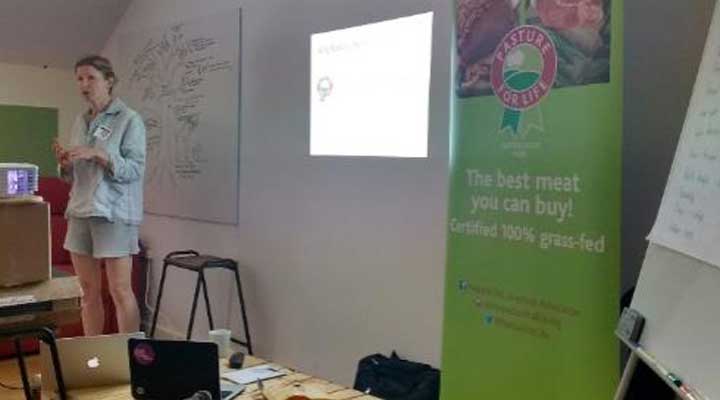
Christine explained how she no longer vac pacs meat (on advice from Pasture for Life butcher the Egg House butchery, as it draws out the moisture from inside the meat to the outside and looks bloody when defrosted) and instead wraps the meat in butchers packaging with a PE coating which is freezer and wet proof. Mince keeps a week in the fridge in this way. Joints she puts in a bag as well. Only able to do this as has the butchery done on site and she does the wrapping – would struggle to pay a butcher to wrap it this way. The packaging stage of the process is as important as the 2.5 years of raising the animal and she wants it to have the appearance of being a quality product from the packaging too. She has had comments from her customers saying it is like “opening a present”.
Labelling includes the phrase, “born, raised and nurtured at Smiling Tree Farm”. With her meat boxes, she also includes an A4 page about the animal, including name, age and other details – it helps to portray a personal touch.
The 5th Quarter
Andy Rumming, another certified Pasture for Life producer shared some thoughts on maximising the value of the 5th Quarter.
Offal
Andy explained that he sells the offal from his beef animals to his customers. He finds selling cheeks, heart, ox-tail and the hanger steak easy but the liver and kidneys are much harder to sell.
Hides
There is money in leather if you can get your market right. Andy showed off one of his belts and bags. The difficulty is getting someone to tan it. Takes 1.5 years to tan beef hide therefore Andy has been practicing at home with squirrels which only take 3 months! £3000 value in a hide.
Bones
Pasture-fed bones have a market for making bone broth, particularly used by the Paleo community. Can expect to get £2-£4/kilo for bones.
Marketing workshop conclusions
When marketing, PFLA members should avoid acronyms, including ‘PFLA’ (which means very little to customers), and to use ‘Pasture for Life’ instead.
Selling direct requires insurance and a need to register as a food business The best bit about selling direct is: “Actually talking to the customer – making the connection is exciting”.
Day 2: Fordhall Farm
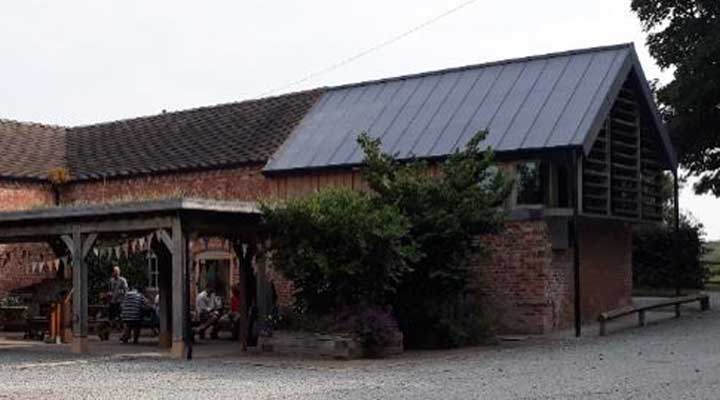
Day 2 began on an ever so slightly cooler note, sat outside Fordhall Farm’s restaurant. Ben Hollins was there to welcome the delegates and provide a bit of background to the history of the farm.
Fordhall Farm has been organic since World War 2. The late Arthur Hollins, Ben’s father, was always doing something a bit different to the mainstream farmer around. In the 1970s they produced yogurts and cheeses and sold these to Fortnum and Masons, amongst other retailers. In 2004 the tenancy expired and Ben and his sister Charlotte did not want to lose the farm. An 18-month tenancy with the option to purchase for £800,000 was negotiated. They set up an Industrial Provenance Society, sold £50 shares during 2004-2006, which enabled the society to purchase the farm. Ben now rents the farm from the society (on a 100 year tenancy). The farm is now 270 acres and is run by Ben and one-part-time stockman. From their 52 breeding cattle, 100 ewes and 6 sows, they sell 1 beef animal, 3-4 lambs and 2-4 pigs every week. All of these are sold direct, mainly through the shop, their online shop, wholesale pork pies to other farm shops and via their event catering trailers (of which they have 7 and a built-in kiosk at Edgbaston).
AHDB Workshop
Liz Ford – Selection for slaughter
Liz recommended visiting AHDB Better Returns Website where you can find useful tools including virtual beef and lamb programme.

Liz began by outlining the EUROP grid for the classification of beef carcasses, which is used as a means to describe and categorise beef carcasses according to confirmation and fat cover in abattoirs processing more than 75 cattle per week.
The best places to handle the live animal to determine its confirmation are: loin, shoulder and rump (always on the left side of the animal).
And the places to handle the animal to determine its fat cover are: ribs, tail head, flank, shoulder blade, brisket.
As an example, when handling the ribs, you want to be able to feel the ribs with slight pressure (no flesh goes on to ribs, just fat, so it is a good place to measure).
Fat
There are 3 types of fat on a carcass:
- Intra-muscular (marbling)
- Inter-muscular (between the muscles)
- External
Interestingly, Holsteins have been found to have the most marbling. At around 16-18 months of age (that’s the average, later with slower maturing animals), beef animals’ daily live weight gains tend to drop significantly. In the later stages of growth it takes more energy to put fat on that muscle – up to 4 times more! Liz recommended that ideally heifers should be away by 21 months and steers by 22 months and dairy calf bull ideally pre-15 months (for an average animal, not necessarily a slow maturing one).
An even distribution of fat cover is required for hanging and dry ageing.
Taste
Taste is made up of:
- Tenderness
- Juiciness
- Flavour
Other considerations for meat quality
It is believed that to best avoid gristle in meat, the animal’s nutritional intake should be kept even throughout the year.
A ‘dark cutter’ where the meat appears very dark in colour means that the animal probably suffered some form of stress (which could include heat/weather, or poor handling) during the last 24-48 hours of life.
The “killing out percentage” indicates the deadweight of the carcass as a proportion of the live weight of the animal. The average killing out percentage according to AHDB is 54%.
When hanging, hip suspension can be considered over leg suspension as it will increase tenderness before rigor mortis has set in, although not all abattoirs are set up for this (as it takes up more space).
Fordhall Farm tour
Practical carcass and confirmation examinations.
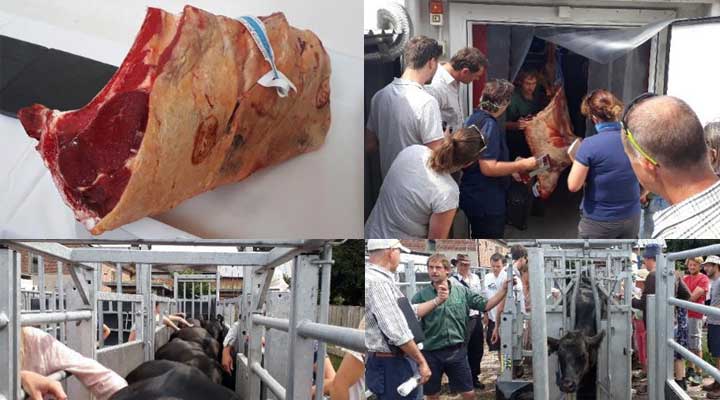
Following the AHDB workshop, delegates were invited to figure out the grade of one of Ben’s carcasses (top left photo – Grade R3).
Ben also arranged for five nearly finished animals to be run through the farm’s cattle crush so that delegates could take a closer look at the inspection points for confirmation and fat cover. The group discussed which animal they felt would provide the best and most valuable carcass.
Ben gave his own insight, and acknowledged that he will sometimes slaughter animals that are too light in order to keep his butchery stocked. He said that customers were not deterred by the slightly varying sizes of cuts.
Ben explained that they make hay off site (on land they rent from the Wildlife Trust). They are lucky at Fordhall to have 2 distinct soil types. The fields that are on sandy soils are used to out-winter cattle, where they don’t have too much of an impact. The damper meadows are used during the summer months.
At Fordhall they utilise a “foggage” system where they let the grass grow over summer on the sandy fields and leave it as a standing hay crop for grazing over the winter.
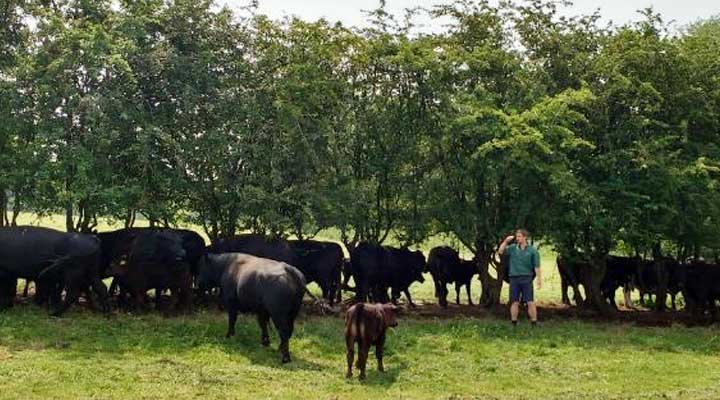
Catering
The old cows and bulls are used for burgers for the catering business when they are retired which means that the breeding stock is rotated frequently. With a bull carcass yielding 5,000 burgers, the breeding stock is proving more valuable than the prime cattle for Ben!
The catering business also works well by providing the butchers with work during times when they would otherwise be quiet (such as in the winter months when they can make burgers). Catering and butchery staff helps each other out during busy spells – this makes for an efficient team.
It was asked whether customers visiting the catering trailers at events etc. were interested in the provenance and pasture-fed certification of the meat they were eating. Ben explained that customers at events were interested in the fact that the meat had come directly from a farm but little more than that. Fordhall’s customers that make their own way to the shop and website are much more likely to be interested in the provenance, age, breed, grass-fed nature of the meat they are buying.
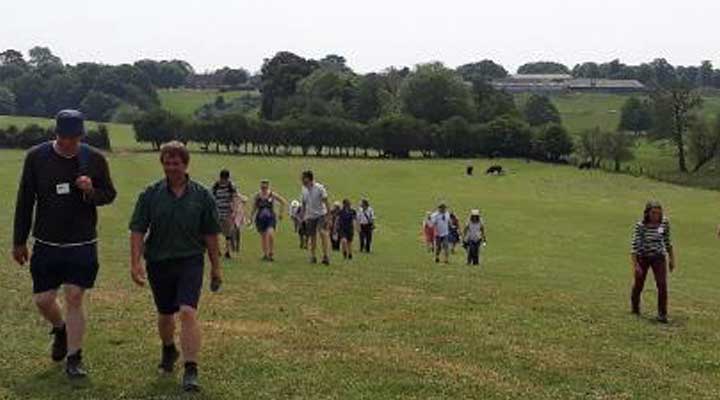
Back to the farm for refuelling on delicious Pasture for Life beef stew cooked up in the Fordhall kitchens.
Silvaspin
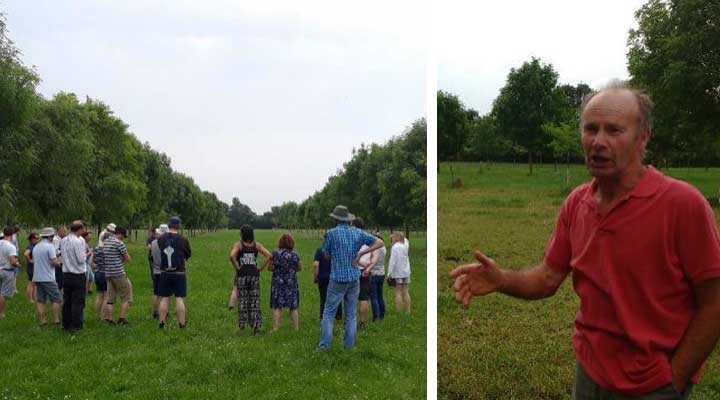
Peter Aspin introduced the Agroforestry site, which he began planting 15 years ago with a huge variety of trees in rows. Combining the principles of forest gardening, permaculture and agriculture, the rows of trees were planted with alleys in between. The alleys are 20 metres wide although Peter suggested making these even wider on a larger farm (40-50m) would still be reasonable. Trees are planted 5 metres apart and no single species have been planted directly next to one another. Other than that, he said, there is no planting plan!
He now contract-rears 70-80 Holsteins on the pasture, strip grazing them down the alleys using electric fences – both to segregate paddocks and protect the youngest trees from being barked.
Potential tree crops
Peter very much had in mind that as a whole the system would now produce far more than just firewood and grazing for animals. Other products he had in mind:
- Birch Sap
- Fodder for livestock (possible evidence that browsing trees decreases methane output)
- Seeds/Nuts
- Fruit
- Rubber
- Root beer
Tree species
Light shading trees have been used to encourage grass to continue growing underneath.
Like-wise, late leafing trees are better so that the grass can get established in spring before the trees come into leaf Peter has also selected trees to ensure there are a large variety flowering at different times to ensure insects and pollinators are supported. The species that have been planted by Peter include Siberian and English Elm, 10 varieties of Ash, 20 varieties of Hazel, Walnuts, Sweet chestnuts, Hickory, Ginkgo, Limes and so on. A full list can be found in Annex 1.
Peter encourages all trees to grow at a good rate (not too fast or too slow). He replaces those that don’t grow well and coppices/pollards trees that have grown too quickly.
He places manure or mulches around the trees when young, otherwise they are left to fend for themselves and grow strong.
Trees for the land and livestock
The rows of trees and alleys in between appear to create mild winds, which keep the air circulating.
Tree litter and leaves are excellent compost for the ground. The perennial crop of leaves is much better for the land/soil. It is almost impossible to put a value on what the trees are doing for the land, but there is something!
Noticed that under the common walnut the flies do not bother the livestock – useful in the summer months.
Pests
Peter uses decoys to deter pests. Eg. Puts Ash branches on the ground, which rabbits go for instead of the young trees. Move fences out to protect the young trees from browsing livestock.
Useful books Peter recommended: Earth Care Manual; Agroforestry Strategy Systems; Forest Gardens – Martin Crawford In closing, Peter said: “You don’t plant trees for yourself”
Conclusions
Russ Carrington wrapped up the last 2 days and asked delegates what they would now do differently and for any other comments they had. A list of responses follows:
- Plan, rather than free styling
- Given me the confidence to sell direct
- Appreciate the enthusiasm/willingness to share and discuss problems – find this exciting and look forward to learning more
- Future is in selling direct?
- Better marketing/social media/getting the word out
- Look into micro-dairying opportunities
- Fascinating!
- Am I doing the right thing in trying to wind down and retire?! Perhaps I should hand over to next generation?
- Refreshing to have variety of thinking, coming from conventional background
- Inspired by the catering at Fordhall and what a good business it had become in so little time
- Confidence to have a go, eg. Direct selling
- Can’t find this information anywhere else!
- Increase advertising
- Not feeling alone – “everyone is as mad as me”!
- Find a solution to rain water harvesting
- Use community to find something sustainable
- Get some shelter belts in
- Get a burger van
- Plant more trees – make a plan!
- Get cows!
- Make smaller paddocks for sheep
- Lots of ideas including incorporating a lot more trees
- Inspiring!
- Get a cattle handling system “with a round thing” (and not cooking for husband until get one!)
- Move from paddock to mob grazing
- Rejuvenate herbal leys
- Cull cows and make into burgers
- Tree/shrub planting to benefit laying hens
- Direct selling and burgers
- Put in successful beef handling unit
- Confidence/reassurance that you’re doing something right
- Importance of added value – utilise everything – decrease wastage
- Improve outputs, decrease costs
- Motivational visits and motivational group
- Move farm to 100% pasture fed
- Move towards 0 injections
- Concrete water troughs
- Put in rain water harvesting
- Confidence to go through with first box scheme and get certified
- Get infrastructure right
- Helpful, open hosts
- Get 1st animal off
- Learn more about trees
- Positive attitude of group and hosts
- Continue sharing with new entrants/members coming in
Our greatest thanks go to all of our hosts and to the delegates for an inspiring and knowledgeable couple of days.



